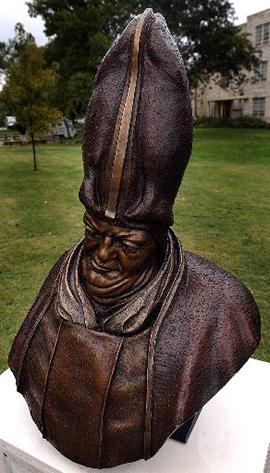The O’Connor v. Washburn University, 416 F.3d 1216 (10th Cir. 2005), decision by the Tenth Circuit Court of Appeals affirmed a federal district court decision denying damages to individuals who alleged that a religious sculpture displayed on the Washburn University campus (a public university) violated the First Amendment.
Controversial statue was seen as state-sponsored disapproval of religion
Holier Than Thou, which had been chosen as part of a temporary outdoor sculpture exhibit, depicted a Catholic bishop with a liturgical head covering, or miter, that some had interpreted to be “a stylized representation of a phallus.” A faculty member and a student, both Roman Catholics, argued that the display of the exhibit demonstrated “state-sponsored disapproval of their religious beliefs.”
Circuit Court applied endorsement test and denied damages
The Tenth Circuit found that because the temporary exhibit and the statue had been removed, requests for injunctive and declaratory relief were moot, but it found that the plaintiffs had standing because they were exposed to the exhibit as part of their routine participation in campus life. Judge Michael R. Murphy applied the endorsement test that Justice Sandra Day O’Connor had formulated and considered in the recent Supreme Court decisions McCreary County v. American Civil Liberties Union (2005) and Van Orden v. Perry (2005), dealing with Ten Commandments displays.
Murphy did not find that the committee members who had chosen to display the statue had selected it because they thought it conveyed sexual imagery or because they were trying to send an anti-Catholic message. Likewise, the committee appeared to choose the site of the display near a footpath to correspond to the size of the exhibit rather than to aggravate passersby. Murphy did not think that a “reasonable observer aware that the statute was part of an outdoor art exhibit” would “believe the university endorsed the message of any particular piece of art within the exhibit.”
Murphy compared this case to Bauchman v. West High School (1997), in which the Tenth Circuit had upheld a school choir’s performance of songs with religious themes, and to Linnemeir v. Board of Trustees of Purdue University (2001), in which the Seventh Circuit had refused to enjoin the performance of a play named Corpus Christi that many Christians found to be offensive. Citing the Supreme Court decision of Healy v. James (1972), Murphy observed that the sculpture at issue “was displayed in the context of a university campus, a place that is ‘peculiarly the marketplace of ideas.’ ”
The plaintiffs appealed to the U.S. Supreme Court, which denied review on March 6, 2006.
John Vile is a professor of political science and dean of the Honors College at Middle Tennessee State University. He is co-editor of the Encyclopedia of the First Amendment. This article was originally published in 2009.

